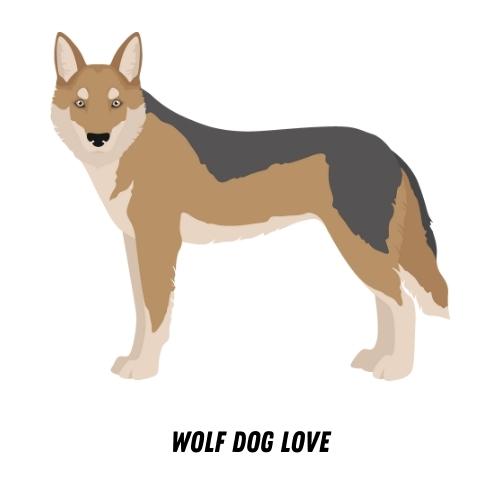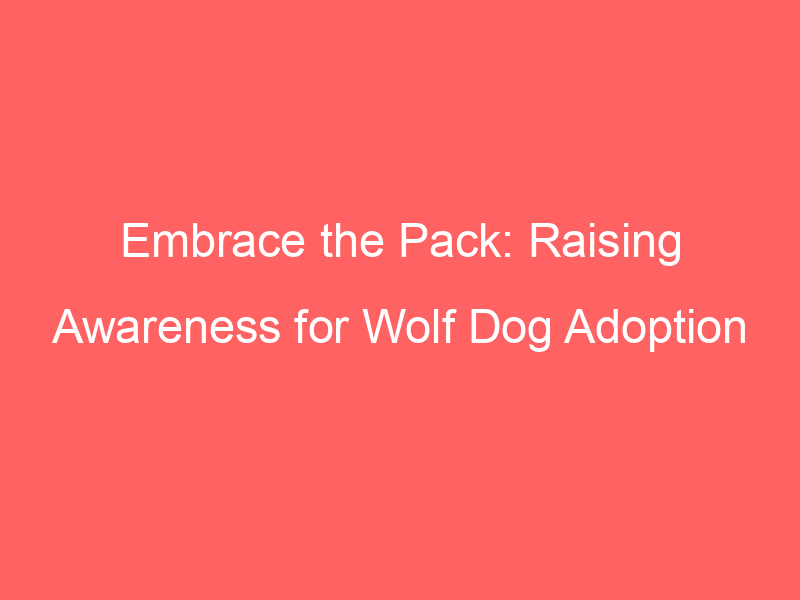Introduction to Wolf Dog Training
Training a wolf dog is a unique experience that requires a deep understanding of their specific needs and behaviors. These majestic creatures are a blend of domestic dogs and wolves, inheriting traits from both. This makes them different from your average pet dog, and thus, they require a different approach to training.
- Understanding the unique needs of wolf dogs
- Importance of agility training for wolf dogs
Wolf dogs are naturally intelligent, independent, and energetic. They are also very curious and love to explore their surroundings. This means they need a lot of mental and physical stimulation to keep them happy and healthy. Training a wolf dog is not just about teaching them commands, but also about providing them with the right environment and activities to satisfy their natural instincts.
Agility training is particularly beneficial for wolf dogs. It not only provides them with the physical exercise they need, but also challenges their minds. Agility training involves teaching your wolf dog to navigate through a course of obstacles, which can include jumps, tunnels, and weave poles. This type of training can help improve your wolf dog’s focus, confidence, and overall behavior.
Training a wolf dog is a rewarding journey that can strengthen the bond between you and your pet. However, it’s important to remember that every wolf dog is unique, and what works for one might not work for another. Therefore, patience, consistency, and understanding are key in this process.
Celebrating Dog Athleticism: The Wolf Dog
Wolf dogs are a unique blend of domestic dog and wild wolf. They are known for their incredible athleticism, which is a testament to their wild heritage. In this section, we will explore the natural athleticism of wolf dogs and how agility training can enhance their performance.
- Exploring the natural athleticism of wolf dogs
Wolf dogs are naturally athletic creatures. Their wolf ancestry equips them with a high level of stamina, agility, and strength. They are capable of running at high speeds, jumping great distances, and navigating through complex terrains with ease. This natural athleticism is a part of their survival instincts, which have been passed down from their wild ancestors.
Wolf dogs are also known for their endurance. They can keep going for hours without showing signs of fatigue. This is because, in the wild, wolves often have to travel long distances in search of food. This trait has been inherited by wolf dogs, making them highly energetic and active.
- How agility training enhances a wolf dog’s athletic performance
Agility training is a fantastic way to harness the natural athleticism of wolf dogs. It involves teaching them to navigate through a series of obstacles, such as jumps, tunnels, and weave poles. This not only provides a physical workout but also stimulates their mental faculties.
Agility training can significantly enhance a wolf dog’s athletic performance. It improves their coordination, increases their flexibility, and strengthens their muscles. It also boosts their confidence and gives them a sense of purpose. Moreover, agility training can help to strengthen the bond between you and your wolf dog, as it requires a high level of communication and teamwork.
Wolf dogs are naturally inclined towards agility training due to their wild instincts. In the wild, wolves have to navigate through various obstacles in their environment. Therefore, agility training is a great way to tap into these instincts and provide a stimulating and rewarding activity for your wolf dog.
In conclusion, wolf dogs are incredibly athletic creatures. Their natural athleticism, combined with the right training, can result in a highly agile and active dog. So, if you have a wolf dog, consider incorporating agility training into their routine. It will not only enhance their athletic performance but also provide a fun and rewarding activity for both of you.
Dog Agility Training: Techniques and Benefits
Training your wolf dog in agility can be a rewarding experience. Not only does it provide physical exercise, but it also stimulates their mind and strengthens your bond. Let’s explore some techniques to get started.
Agility Training Techniques for Wolf Dogs
Wolf dogs are intelligent and athletic animals. With the right approach, they can excel in agility training. Here are some techniques to get you started:
- Introducing your wolf dog to agility equipment
- Teaching basic agility commands
Start by introducing your wolf dog to the agility equipment in a calm and controlled environment. Let them sniff and explore the equipment at their own pace. This can include tunnels, weave poles, and jumps. Remember, the goal is to make your dog comfortable with the equipment.
Once your wolf dog is comfortable with the equipment, you can start teaching basic commands. Start with simple commands like ‘sit’, ‘stay’, and ‘come’. Gradually, introduce commands like ‘jump’, ‘weave’, and ‘tunnel’. Remember to always use positive reinforcement, such as treats and praise, to encourage your dog.
Training a wolf dog in agility requires patience and consistency. But the rewards are worth it. Not only will your dog get a great workout, but you’ll also strengthen your bond and have a lot of fun in the process.
Remember, every dog is unique. What works for one might not work for another. So, be patient, stay positive, and enjoy the journey of training your wolf dog in agility.
Benefits of Dog Agility Training
Agility training for wolf dogs offers a multitude of benefits. Not only does it provide an excellent form of exercise, but it also stimulates the dog’s mind and strengthens the bond between the dog and its owner. Here are the top three benefits of dog agility training:
- Improved Physical Health
Wolf dogs are naturally athletic and agile. Agility training provides them with a structured way to exercise, which helps to maintain their physical health. It improves their cardiovascular fitness, builds muscle strength, and enhances their overall stamina. This type of training also helps to keep their weight in check, reducing the risk of obesity-related health issues.
- Enhanced Mental Stimulation
Agility training is not just about physical exercise. It also provides mental stimulation for your wolf dog. The various obstacles and commands involved in agility training require your dog to think and make quick decisions. This mental workout helps to keep their minds sharp and active, reducing the risk of cognitive decline as they age.
- Strengthened Bond between Owner and Wolf Dog
Training your wolf dog in agility requires a lot of communication and teamwork between you and your dog. This shared experience helps to strengthen the bond between you. It builds trust and mutual respect, and it can even improve your dog’s behavior outside of the training sessions. Plus, it’s a great way to spend quality time with your furry friend!
In conclusion, agility training is a fantastic way to keep your wolf dog physically fit, mentally stimulated, and emotionally connected to you. It’s a fun and rewarding activity that both you and your dog can enjoy together.
Training Athletic Dogs: Case Studies
Training an athletic dog, particularly a wolf dog, can be a rewarding experience. It requires patience, dedication, and a deep understanding of the dog’s natural instincts and abilities. Let’s take a look at two case studies that highlight the potential of these magnificent animals and the challenges faced in their training.
- Case Study 1: Maximizing the Athletic Potential of a Wolf Dog
- Case Study 2: Overcoming Challenges in Agility Training
Meet Max, a two-year-old wolf dog who was initially shy and reserved. His owner, a professional dog trainer, recognized Max’s athletic potential and decided to harness it. The first step was to build trust and rapport with Max. This was achieved through consistent feeding, regular walks, and playtime. Once Max felt secure, the real training began.
Max was introduced to a variety of agility exercises, starting with simple ones like jumping over hurdles and weaving through poles. Over time, Max’s confidence grew, and he was able to tackle more complex tasks. The key to Max’s success was a gradual increase in difficulty and constant positive reinforcement. Today, Max is an agility champion, showcasing the athletic potential of wolf dogs.
Next, we have Bella, a three-year-old wolf dog. Bella’s owner faced numerous challenges in agility training, primarily due to Bella’s independent nature. Bella was less interested in pleasing her owner and more focused on exploring her surroundings. This made traditional training methods less effective.
However, Bella’s owner didn’t give up. She started incorporating Bella’s love for exploration into the training. For instance, instead of a regular agility course, Bella was trained on a course that mimicked a forest trail. This made the training more engaging for Bella, and she started showing significant improvement. Bella’s case demonstrates that sometimes, unconventional methods can lead to great success.
These case studies illustrate that with patience, understanding, and a bit of creativity, it’s possible to maximize the athletic potential of wolf dogs and overcome training challenges. The key is to work with the dog’s natural instincts and make the training process enjoyable for them.
Wolf Dog Agility Competitions
Wolf dog agility competitions are a thrilling showcase of athleticism, intelligence, and the strong bond between a wolf dog and its handler. These events are not just about winning; they’re about celebrating the unique abilities of these extraordinary animals. Let’s delve into understanding the rules of these competitions and how to prepare your wolf dog for them.
- Understanding the Rules and Requirements of Agility Competitions
- Preparing Your Wolf Dog for Competition
- Basic Obedience Training: Before you start agility training, your wolf dog should have a solid foundation in basic obedience commands like sit, stay, and come.
- Physical Conditioning: Agility competitions require a high level of physical fitness. Regular exercise, including walks, runs, and play sessions, will help keep your wolf dog in top shape.
- Agility Training: Start with simple obstacles and gradually introduce more complex ones. Practice regularly, but remember to keep training sessions fun and positive.
- Building Confidence: Encourage your wolf dog and reward it for successfully navigating obstacles. This will build its confidence and make it more comfortable in a competition setting.
Agility competitions are designed to test a dog’s speed, agility, and obedience. The competition involves a course with various obstacles that the dog must navigate under the guidance of its handler. The course may include jumps, tunnels, weave poles, and seesaws.
Each competition has its own set of rules, but generally, the dog that completes the course in the shortest time with the fewest mistakes wins. Penalties are given for errors like knocking down a jump bar, missing a contact zone, or taking the obstacles out of order. It’s essential to familiarize yourself with the specific rules of the competition you’re entering.
Preparing your wolf dog for an agility competition involves both physical and mental training. Here are some steps to get you started:
Remember, the goal of agility competitions is to have fun and strengthen the bond with your wolf dog. Winning is just a bonus!
Wolf Dog Agility Exercises: A Step-by-Step Guide
Wolf dogs are known for their athleticism and agility. Training them to navigate through an agility course not only provides them with mental stimulation but also helps to strengthen the bond between you and your pet. This guide will walk you through the process of setting up your own agility course and introducing your wolf dog to each obstacle.
- Setting up your own agility course
- Choose a suitable location: Your backyard or a local park can be perfect. Ensure the area is spacious and safe for your pet to run around.
- Select the obstacles: You can use a variety of obstacles such as jumps, tunnels, weave poles, and seesaws. Remember to choose obstacles that are appropriate for your dog’s size and skill level.
- Arrange the obstacles: Start with a simple layout and gradually increase the complexity as your dog gets more comfortable. Always leave enough space between each obstacle for your dog to run.
- Introducing and mastering each agility obstacle
- Start with one obstacle: Begin with a simple obstacle like a jump. Use treats or toys to encourage your dog to go over the jump.
- Gradually introduce more obstacles: Once your dog is comfortable with one obstacle, introduce the next. Remember to always reward your dog for successfully completing an obstacle.
- Practice makes perfect: Consistent practice is key to mastering agility exercises. Make sure to practice regularly but also allow your dog enough rest.
Creating an agility course for your wolf dog can be a fun and rewarding experience. Here are some steps to guide you:
Introducing your wolf dog to the agility obstacles should be a gradual process. Here’s how to do it:
In conclusion, wolf dog agility exercises can be a great way to engage your pet both physically and mentally. Remember, the goal is to have fun and strengthen your bond with your pet. So, take it slow, be patient, and enjoy the process.
| Obstacle | Description | Difficulty Level |
|---|---|---|
| Jump | A hurdle that your dog must jump over. | Easy |
| Tunnel | A tunnel that your dog must run through. | Medium |
| Weave Poles | A series of poles your dog must weave through. | Hard |
| Seesaw | A seesaw that your dog must balance on and cross. | Hard |
Conclusion: Celebrating the Athleticism in Wolf Dogs
As we reach the end of our exploration into the world of wolf dog athleticism, it’s time to reflect on the journey and look forward to the future. Wolf dogs are a unique breed, possessing a blend of wild instinct and domesticated intelligence that makes them exceptional athletes. Their agility and strength are not just for show; these traits are deeply ingrained in their DNA, a testament to their wild ancestry.
- Reflecting on the journey of agility training
- Continuing to nurture your wolf dog’s athletic abilities
Training a wolf dog for agility competitions is a journey that requires dedication, patience, and a deep understanding of your dog’s unique needs and abilities. We’ve discussed various training techniques, from basic obedience training to more advanced agility exercises. We’ve seen how these techniques can enhance a wolf dog’s natural athleticism, and how they can foster a stronger bond between you and your pet.
But the journey doesn’t end here. Your wolf dog’s athletic abilities should continue to be nurtured and developed. Regular exercise and training are crucial, not just for competition, but for your dog’s overall health and well-being. Remember, a well-exercised wolf dog is a happy wolf dog!
In conclusion, the athleticism of wolf dogs is something to be celebrated and nurtured. These magnificent animals are not just pets; they are athletes in their own right. By understanding and respecting their unique abilities, we can help them reach their full potential and live happier, healthier lives.








